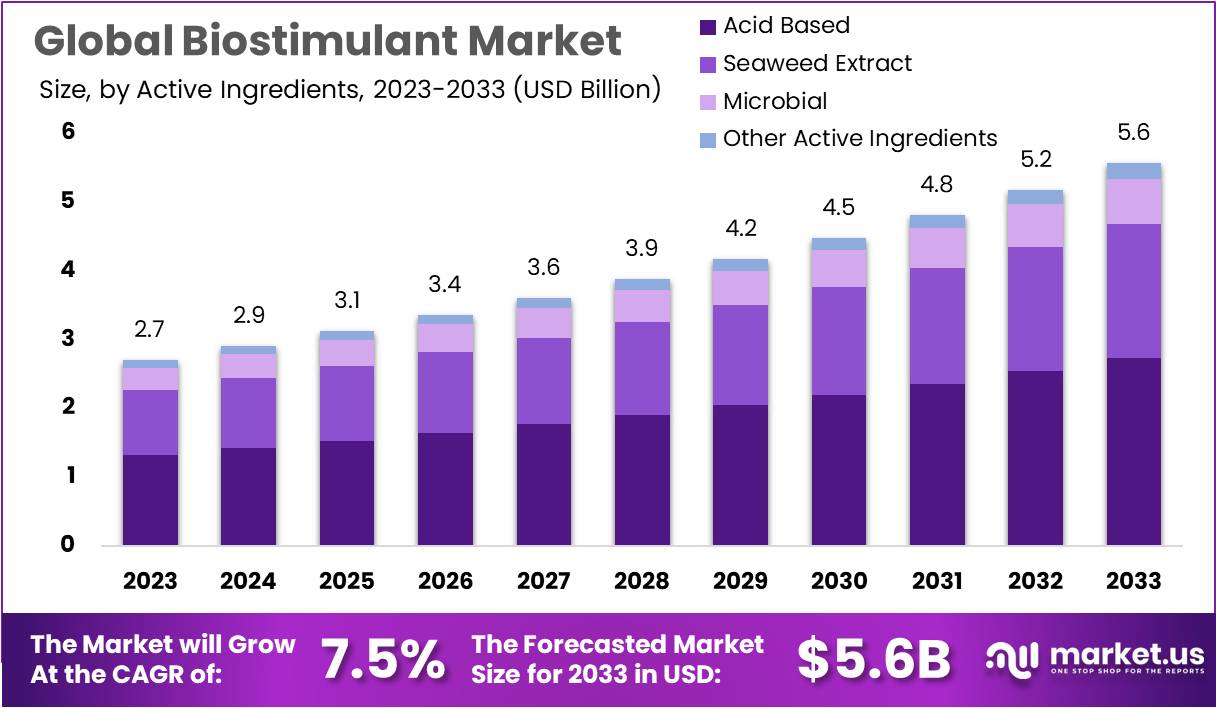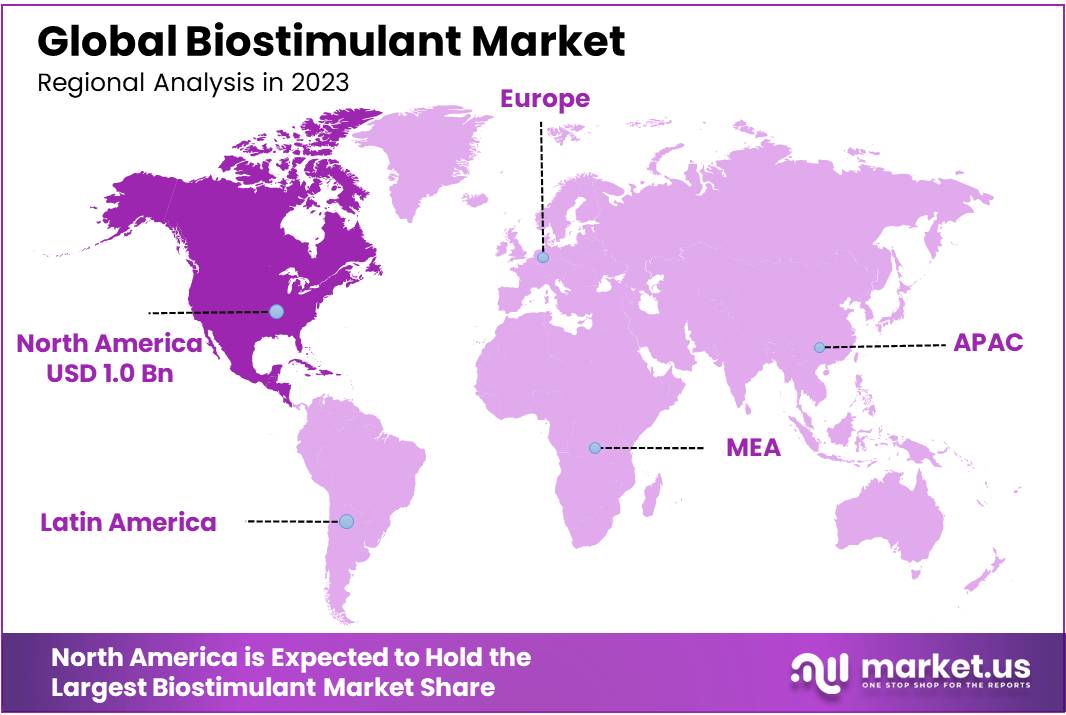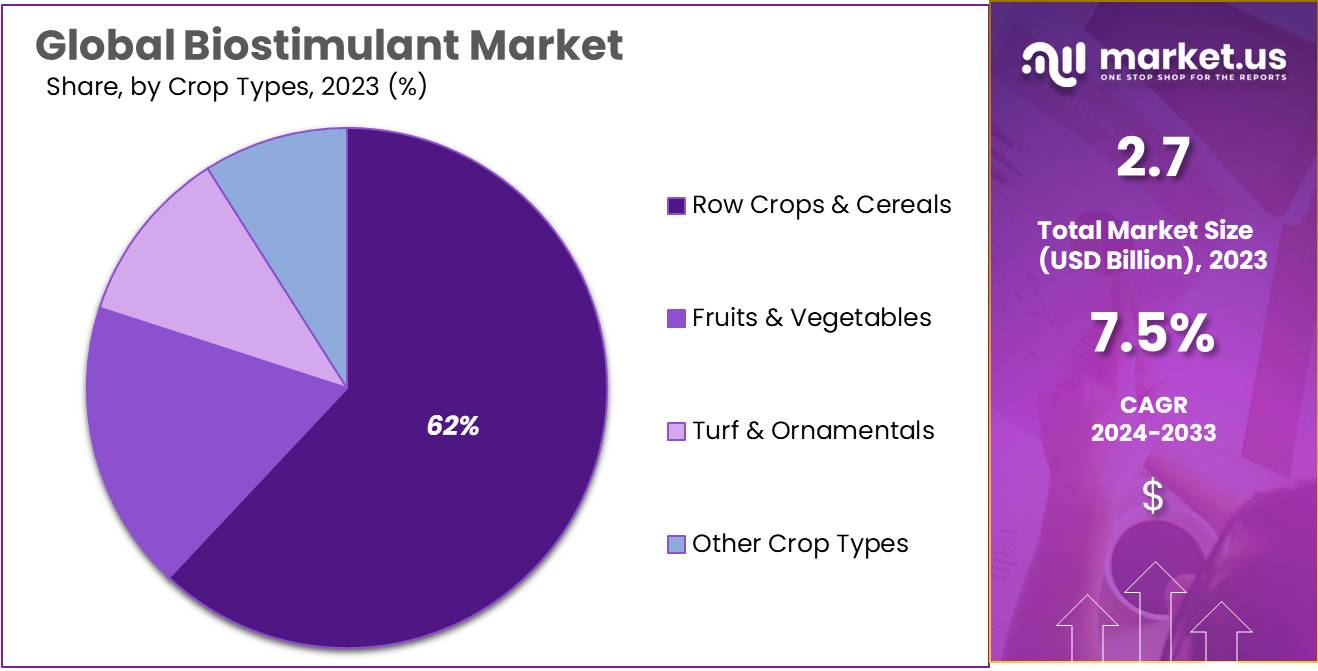New York, Jan. 29, 2024 (GLOBE NEWSWIRE) -- According to Market.us, the Biostimulant Market size is forecasted to exceed USD 5.6 Billion by 2033, with a promising CAGR of 7.5% from 2024 to 2033.
The Biostimulant Market has experienced strong growth, driven by the worldwide transition to sustainable agriculture. Farmers are progressively recognizing the advantages of combining biostimulants with conventional fertilizers, motivated by strict environmental regulations. Continuous research and development endeavors are producing inventive formulations to augment the effectiveness of biostimulants, addressing the increasing need for environmentally friendly solutions.
Download our Sample Report to discover how recent industry developments@ https://market.us/report/biostimulant-market/request-sample/

Key Takeaway
- Based on active ingredients, the acid-based active ingredients segment maintained a stronghold on the market, with a market share of 49%.
- When classified based on Crop Type, the segments observed in the market are row crops and cereals, fruits and vegetables, turf and ornamentals, and others. the row crops and cereals segment managed to achieve the highest revenue share in 2023, reaching 62%.
- As far as Application is concerned, the market shows three distinct segments namely, foliar treatment, soil treatment, and seed treatment. Among these segments, the foliar segment will be the largest contributor to the biostimulant market in 2023.
- Europe remained the largest contributor to the market, with a dominating market share of 38.5%.
Factors affecting the growth of the Biostimulant Market
- The increasing popularity of organic farming and shifting preference towards sustainable practices have encouraged the growth of the biostimulant market.
- Strict regulatory processes often discourage new players from entering the market. The high research and development costs act as barriers to entry as well. These factors effectively hinder market growth.
- There has been increasing demand for sustainable agriculture, especially in developing countries. This has encouraged the use of precision agriculture practices with digitalization and data-driven technologies, which has ultimately propelled the growth of the market.
Top Trends in the Global Biostimulant Market
- The increasing adoption of biostimulants, particularly in specialty crops such as fruits and vegetables, is a noteworthy trend driven by the higher value of these crops and the pronounced benefits offered by biostimulants.
- A significant development is the integration of biostimulants with precision agriculture practices, leveraging data-driven technologies for targeted applications and optimal results. Moreover, there is a noticeable shift towards incorporating biological-based ingredients in biostimulant formulations, aligning with consumer preferences for natural and sustainable products.
- An emerging trend is the digitalization of agriculture for biostimulant management, involving the adoption of technologies like monitoring and data analytics. This digitization enhances precision and overall efficiency in farming practices, marking a transformative shift in the application of biostimulants in modern agriculture.
Market Growth
The biostimulant market is experiencing robust growth driven by several factors. The increasing awareness of environmental impact and a growing emphasis on sustainable agricultural practices have elevated the demand for biostimulants. Favorable government policies and regulations, including subsidies and incentives, contribute significantly to market expansion. The integration of biostimulants with precision agriculture practices, the adoption of digital technologies, and the rising trend of using biological-based ingredients in formulations further propel the market forward.
Emerging economies present untapped potential, where heightened awareness and economic development are expected to drive biostimulant adoption. Innovations in formulations, strategic collaborations, and a shift toward organic farming practices also contribute to the dynamic growth of the biostimulant market, positioning it as a key player in the evolving landscape of modern agriculture.
Macroeconomic Factors
The overall economic health of countries and regions can impact the purchasing power of farmers and agricultural businesses. Economic downturns may lead to reduced spending on agricultural inputs, including biostimulants. Government policies, regulations, and subsidies play a crucial role in the development of the biostimulant market.
Supportive policies and financial incentives for sustainable agriculture can boost the adoption of biostimulants. Shifting consumer preferences towards organic and sustainably produced agricultural products can influence farming practices. Farmers may turn to biostimulants to align with market demands. International trade relations and disruptions in global supply chains can also affect the availability and pricing of biostimulant ingredients, impacting the overall market.
Regional Analysis
In 2023, Europe emerged as the dominant market for biostimulants, holding over 38.5% market share with a market value of USD 1.0 billion for the year. This strong position is a result of the widespread adoption of biostimulants among farmers and growers in the region. Key markets within Europe, including Spain, Italy, France, and Germany, have seen substantial growth driven by favorable government policies, increasing awareness of sustainable agriculture practices, and a growing need to enhance crop quality and yields.
North America closely follows Europe in market influence, securing a significant market share. Key players in the United States and Canada are leading advancements in research and product innovations, backed by regulatory support and subsidies for the adoption of biostimulants. The Asia Pacific region is poised to experience the highest growth rate in the foreseeable future. Factors such as rapid population growth, diminishing arable land, initiatives to enhance agricultural productivity, and government funding in significant countries like China and India are anticipated to drive regional growth in the biostimulants market.
Explore the strategic advantages our report holds for your business. Request a brochure to find out more https://market.us/report/biostimulant-market/#inquiry

Scope of the Report
| Report Attributes | Details |
| Market Value (2023) | USD 2.7 Billion |
| Forecast Revenue 2033 | USD 5.6 Billion |
| CAGR (2023 to 2033) | 7.5% |
| Europe Revenue Share | 38.5% |
| Base Year | 2023 |
| Historic Period | 2018 to 2022 |
| Forecast Year | 2024 to 2033 |
Market Drivers
The rising interest in sustainable agriculture is driven by an increasing awareness of environmental consequences. Biostimulants, which enable farmers to improve crop yields while mitigating ecological impact, are a central aspect of this trend. Encouraging government policies and regulations, including subsidies and incentives, play a crucial role in fostering market expansion and promoting widespread usage.
Furthermore, the growing global emphasis on organic farming practices is a significant driving factor. Biostimulants, essential to organic agriculture, assist in plant growth and nutrient absorption, aligning with the broader trend towards environmentally friendly and sustainable farming approaches.
Market Restraints
The significant barrier of exorbitant research and development expenses poses a major challenge for smaller companies seeking entry into the biostimulant market. This financial obstacle arises from the substantial upfront investment needed. Moreover, there is a widespread lack of knowledge among farmers, especially in developing areas, regarding the advantages of biostimulants. Addressing this hurdle requires the implementation of thorough educational and outreach initiatives.
Market Opportunities
In the ever-evolving biostimulant market, significant opportunities are present in emerging economies, where increased awareness and economic growth are expected to boost the adoption of biostimulants. Strategic collaborations between manufacturers and agricultural entities, research institutions, or government bodies serve as effective approaches for improving products and expanding market presence. Continuous innovations in formulations, integrating new ingredients and advanced delivery methods, allow companies to set their offerings apart.
Moreover, the global emphasis on sustainable agricultural practices positions biostimulant manufacturers to meet the growing demand for environmentally friendly alternatives, aligning with the global push for sustainable solutions.
Instant Access Upon Purchase | Get This Premium Research Report Now https://market.us/purchase-report/?report_id=47860
Report Segmentation of the Biostimulant Market
Active Ingredients Insight
On a global scale, the acid-based active ingredients segment took the lead, constituting more than 49% of the total revenue in 2023. These ingredients are in high demand owing to their ability to enhance potency and sustainability, making them economically viable. Amino acids such as fulvic acid and humic acid play a crucial role as catalysts for plant hormones, promoting metabolic processes, and enhancing seed germination.
Crop Type Insight
In 2023, the row crops and cereals segment held a prominent market position, commanding a majority share of over 62%. This segment encompasses crops such as cotton, soybean, millet, and barley, offering companies significant growth prospects, particularly due to their cultivation over extensive agricultural lands. The cultivation of these crops contributes to the enlargement of seed size, enhanced harvests, and an accelerated rate of cell division.

Application Insight
As of 2023, the Foliar treatment segment has secured a dominant market position, commanding over 80% market share. Foliar treatment offers various advantages, such as heightened cellular activity and accelerated nutrient absorption. This method entails directly administering biostimulants to plant leaves, facilitating the swift assimilation of nutrients. The epidermis, stomata, and other surface components of the leaves play a role in aiding absorption. Biostimulants are typically in liquid form for foliar treatment to ensure easy application and absorption. Seed treatment stands out for its cost-effectiveness and efficiency, requiring less labor compared to alternative methods.
To Gain greater insights, Request a sample report @ https://market.us/report/biostimulant-market/request-sample/
Market Segmentation
By Active Ingredients
- Acid-based
- Seaweed Extract
- Microbial
- Other Active Ingredients
By Crop Type
- Row Crops & Cereals
- Fruits & Vegetables
- Turf and Ornamentals
- Other Crop Type
By Application
- Foliar Treatment
- Soil Treatment
- Seed Treatment
By Geography
North America
- US
- Canada
Europe
- Germany
- France
- The UK
- Spain
- Italy
- Russia
- Netherland
- Rest of Europe
Asia Pacific
- China
- Japan
- South Korea
- India
- New Zealand
- Singapore
- Thailand
- Vietnam
- Rest of APAC
Latin America
- Brazil
- Mexico
- Rest of Latin America
Middle East & Africa
- South Africa
- Saudi Arabia
- UAE
- Rest of MEA
Competitive Landscape
Key companies in the industry are actively involved in continuous Research and Development (R&D), mergers and acquisitions, capacity expansion, and other strategic initiatives to establish a competitive edge in the market. These manufacturers prioritize the expansion of their product portfolios through strategic joint ventures and substantial R&D investments. Significant players in the industry have made noteworthy investments in innovation to address the increasing global demand for agricultural products.
Additionally, these initiatives are aimed at assisting companies in developing new sustainable products, thereby contributing to the growth of their profit margins. This proactive and innovative approach underscores the dynamic and competitive nature of the agricultural market, where key players are keen on staying at the forefront of advancements and market trends.
Market Key Players
- Bayer AG
- Isagro Group
- BASF SE
- Biolchim S.P.A.
- Novozymes A/S
- Valagro SpA
- Koppert B.V.
- Biostadt India Limited
- Marrrone Bio Innovations
- Syngenta AG
Recent Development of the Biostimulant Market
- In August 2023, Lallemand, recognized for its proficiency in yeast and bacteria fermentation, completed the acquisition of Biotalys, a company specializing in innovative biostimulants and biocontrol solutions. Valued at $1.1 billion, this strategic move is poised to strengthen Lallemand's position in the biostimulant market, paving the way for promising future growth.
- In June 2023, Novozymes, a leading figure in bio innovation, introduced ProTera, a groundbreaking biostimulant with the potential to boost crop yields by up to 15%. ProTera, a natural product, achieves this by optimizing plant nutrient absorption and water utilization, signaling a significant advancement in agricultural technology.
- In May 2023, a noteworthy collaboration unfolded between BASF, a prominent global chemical leader, and Corteva Agriscience, a renowned entity in the agricultural domain. This strategic alliance is centered around the joint development of state-of-the-art biostimulants. Leveraging BASF's expertise in chemistry and Corteva's agricultural know-how, the collaboration aims to produce innovative products designed to assist farmers in improving both crop yields and quality. This partnership signifies a convergence of skills from different sectors to address challenges in modern agriculture and advance sustainable practices.
Explore More Chemicals and Materials Market Research Reports
- Mushroom Market size was worth USD 56 billion. It is estimated to reach USD 136 billion in 2032 growing at a CAGR of 9.5% between 2023-2032
- Indoor farming market size was valued at USD 33.9 billion and will reach USD 93.0 billion by 2032. Between 2023 and 2032, this market is estimated to register the highest CAGR of 10.9%.
- Honey market size is expected to be worth around USD 15.4 billion by 2033, from USD 9.3 billion in 2023, growing at a CAGR of 5.2% during the forecast period from 2023 to 2033.
- Agricultural Robot market size is expected to be worth around USD 86.5 billion by 2033, from USD 13.4 billion in 2023, growing at a CAGR of 20.5% during the forecast period from 2023 to 2033.
- Microirrigation systems market size is expected to be worth around USD 32.2 billion by 2033, from USD 12.0 billion in 2023, growing at a CAGR of 10.5% during the forecast period from 2023 to 2033.
- Carotenoids market size was valued at USD 1,875 Mn in 2022 and is anticipated to reach USD 3,402 Mn by 2032 at a CAGR of 6.3% during the forecast period.
- Precision farming market size is expected to be worth around USD 33.2 billion by 2033, from USD 10.5 billion in 2023, growing at a CAGR of 12.2% during the forecast period from 2023 to 2033.
- Commercial greenhouse market was valued at USD 34.5 billion. This market is estimated to reach USD 95.4 billion in 2032 at a CAGR of 11% between 2023 and 2032.
- Insect Repellent Market size is expected to be worth around USD 26 Billion by 2033, from USD 5 Billion in 2023, growing at a CAGR of 6.9% during the forecast period from 2023 to 2033.
- Controlled environment agriculture market size is expected to be worth around USD 377.6 billion by 2032 from USD 74.4 billion in 2022, growing at a CAGR of 18.13% during the forecast period 2022 to 2032.
Follow Us on LinkedIn
Our Blog:
